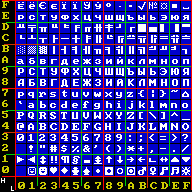Related Research Articles
ISO/IEC 8859-11:2001, Information technology — 8-bit single-byte coded graphic character sets — Part 11: Latin/Thai alphabet, is part of the ISO/IEC 8859 series of ASCII-based standard character encodings, first edition published in 2001. It is informally referred to as Latin/Thai. It is nearly identical to the national Thai standard TIS-620 (1990). The sole difference is that ISO/IEC 8859-11 allocates non-breaking space to code 0xA0, while TIS-620 leaves it undefined.

Code page 855 is a code page used under DOS to write Cyrillic script.

Code page 866 is a code page used under DOS and OS/2 in Russia to write Cyrillic script. It is based on the "alternative code page" developed in 1984 in IHNA AS USSR and published in 1986 by a research group at the Academy of Science of the USSR. The code page was widely used during the DOS era because it preserves all of the pseudographic symbols of code page 437 and maintains alphabetic order of Cyrillic letters. Initially, this encoding was only available in the Russian version of MS-DOS 4.01 (1990) and since MS-DOS 6.22 in any language version.
Windows code page 1253, commonly known by its IANA-registered name Windows-1253 or abbreviated as cp1253, is a Microsoft Windows code page used to write modern Greek. It is not capable of supporting the older polytonic Greek.
Windows-1255 is a code page used under Microsoft Windows to write Hebrew. It is an almost compatible superset of ISO-8859-8 – most of the symbols are in the same positions, but Windows-1255 adds vowel-points and other signs in lower positions.
Windows-1256 is a code page used under Microsoft Windows to write Arabic and other languages that use Arabic script, such as Persian and Urdu.
Windows-1257 is an 8-bit, single-byte extended ASCII code page used to support the Estonian, Latvian and Lithuanian languages under Microsoft Windows. In Lithuania, it is standardised as LST 1590-3, alongside a modified variant named LST 1590-4.
Code page 865 is a code page used under DOS in Denmark and Norway to write Nordic languages.
Code page 860 is a code page used under DOS in Portugal to write Portuguese and it is also suitable to write Spanish and Italian. In Brazil, however, the most widespread codepage – and that which DOS in Brazilian Portuguese used by default – was code page 850.
Code page 863 is a code page used under DOS in Canada to write French although it lacks the letters Æ, æ, Œ, œ, Ÿ and ÿ.
Code page 857 is a code page used under DOS in Turkey to write Turkish.

Code page 737 is a code page used under DOS to write the Greek language. It was much more popular than code page 869 although it lacks the letters ΐ and ΰ.

Code page 950 is the code page used on Microsoft Windows for Traditional Chinese. It is Microsoft's implementation of the de facto standard Big5 character encoding. The code page is not registered with IANA, and hence, it is not a standard to communicate information over the internet, although it is usually labelled simply as big5, including by Microsoft library functions.
Code page 720 is a code page used under DOS to write Arabic in Egypt, Iraq, Jordan, Saudi Arabia, and Syria. The Windows (ANSI) code page for Arabic is Windows-1256.
Code page 864 is a code page used to write Arabic in Egypt, Iraq, Jordan, Saudi Arabia, and Syria.
MacGreek encoding or Macintosh Greek encoding is used in Apple Macintosh computers to represent texts in the Greek language that uses the Greek script. This encoding is registered as IBM code page/CCSID 1280 and Windows code page 10006.
Code page 856, is a code page used under DOS for Hebrew in Israel.
Each character is shown with its equivalent Unicode code point. Only the second half of the table is shown, the first half being the same as ASCII.
Code page 868 is a code page used to write Urdu in Pakistan.
Code page 921 is a code page used under IBM AIX and DOS to write the Estonian, Latvian, and Lithuanian languages. It is an extension of ISO/IEC 8859-13.
References
- ↑ "CCSID 1098 information document". Archived from the original on 2016-03-27.
- ↑ "Code page 1098 information document". Archived from the original on 2016-03-17.
- ↑ Code Page CPGID 01098 (PDF), IBM
- ↑ Code Page CPGID 01098 (txt), IBM
- ↑ International Components for Unicode (ICU), ibm-1098_P100-1995.ucm, 2002-12-03